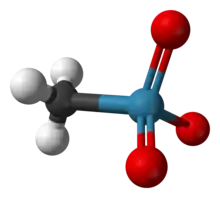Organorhenium chemistry
Organorhenium chemistry describes the compounds with Re−C bonds. Because rhenium is a rare element, relatively few applications exist, but the area has been a rich source of concepts and a few useful catalysts.
General features
Re exists in ten known oxidation states from −3 to +7 except −2, and all but Re(−3) are represented by organorhenium compounds. Most are prepared from salts of perrhenate and related binary oxides.[1] The halides, e.g., ReCl5 are also useful precursors as are certain oxychlorides.
A noteworthy feature of organorhenium chemistry is the coexistence of oxide and organic ligands in the same coordination sphere.[2]
Carbonyl compounds
Dirhenium decacarbonyl is a common entry point to other rhenium carbonyls. The general patterns are similar to the related manganese carbonyls. It is possible to reduce this dimer with sodium amalgam to Na[Re(CO)5] with rhenium in the formal oxidation state −1. Bromination of dirhenium decacarbonyl gives bromopentacarbonylrhenium(I),[3] then reduced with zinc and acetic acid to pentacarbonylhydridorhenium:[4]
- Re2(CO)10 + Br2 → 2 Re(CO)5Br
- Re(CO)5Br + Zn + HOAc → Re(CO)5H + ZnBr(OAc)
Bromopentacarbonylrhenium(I) is readily decarbonylated. In refluxing water, it forms the triaquo cation:[5]
- Re(CO)5Br + 3 H2O → [Re(CO)3(H2O)3]Br + 2 CO
With tetraethylammonium bromide Re(CO)5Br reacts to give the anionic tribromide:[6]
- Re(CO)5Br + 2 NEt4Br → [NEt4]2[Re(CO)3Br3] + 2 CO
Cyclopentadienyl complexes
One of the first transition metal hydride complexes to be reported was (C5H5)2ReH. A variety of half-sandwich compounds have been prepared from (C5H5)Re(CO)3 and (C5Me5)Re(CO)3. Notable derivatives include the electron-precise oxide (C5Me5)ReO3 and (C5H5)2Re2(CO)4.
Re-alkyl and aryl compounds

Rhenium forms a variety of alkyl and aryl derivatives, often with pi-donor coligands such as oxo groups.[7] Well known is methylrhenium trioxide ("MTO"), CH3ReO3 a volatile, colourless solid, a rare example of a stable high-oxidation state metal alkyl complex. This compound has been used as a catalyst in some laboratory experiments. It can be prepared by many routes, a typical method is the reaction of Re2O7 and tetramethyltin:
- Re2O7 + (CH3)4Sn → CH3ReO3 + (CH3)3SnOReO3
Analogous alkyl and aryl derivatives are known. Although PhReO3 is unstable and decomposes at –30 °C, the corresponding sterically hindered mesityl and 2,6-xylyl derivatives (MesReO3 and 2,6-(CH3)2C6H3ReO3) are stable at room temperature. The electron poor 4-trifluoromethylphenylrhenium trioxide (4-CF3C6H4ReO3) is likewise relatively stable.[8] MTO and other organylrhenium trioxides catalyze oxidation reactions with hydrogen peroxide as well as olefin metathesis in the presence of a Lewis acid activator.[9] Terminal alkynes yield the corresponding acid or ester, internal alkynes yield diketones, and alkenes give epoxides. MTO also catalyses the conversion of aldehydes and diazoalkanes into an alkene.[10]
Rhenium is also able to make complexes with fullerene ligands such as Re2(PMe3)4H8(η2:η2C60).
References
- O. Glemser "Ammonium Perrhenate" in Handbook of Preparative Inorganic Chemistry, 2nd Ed. Edited by G. Brauer, Academic Press, 1963, NY. Vol. 1. p. 1476-85.
- W. A. Herrmann and F. E. Kuhn (1997). "Organorhenium Oxides". Acc. Chem. Res. 30 (4): 169–180. doi:10.1021/ar9601398.
- Schmidt, Steven P.; Trogler, William C.; Basolo, Fred (1990). Pentacarbonylrhenium Halides. Inorganic Syntheses. 28. pp. 154–159. doi:10.1002/9780470132593.ch42. ISBN 978-0-470-13259-3.
- Michael A. Urbancic, John R. Shapley (1990). "Pentacarbonylhydridorhenium". Inorganic Syntheses. Inorganic Syntheses. 28. pp. 165–168. doi:10.1002/9780470132593.ch43. ISBN 978-0-470-13259-3.
- Lazarova, N.; James, S.; Babich, J.; Zubieta, J. (2004). "A convenient synthesis, chemical characterization and reactivity of [Re(CO)3(H2O)3]Br: the crystal and molecular structure of [Re(CO)3(CH3CN)2Br]". Inorganic Chemistry Communications. 7 (9): 1023–1026. doi:10.1016/j.inoche.2004.07.006.
- Alberto, R.; Egli, A.; Abram, U.; Hegetschweiler, K.; Gramlich V.; Schubiger, P. A. (1994). "Synthesis and reactivity of [NEt4]2[ReBr3(CO)3]. Formation and structural characterization of the clusters [NEt4][Re3(µ3-OH)(µ-OH)3(CO)9] and [NEt4][Re2(µ-OH)3(CO)6] by alkaline titration". J. Chem. Soc., Dalton Trans. (19): 2815–2820. doi:10.1039/DT9940002815.
- Pericles Stavropoulos, Peter G. Edwards, Geoffrey Wilkinson, Majid Motevalli, K. M. Abdul Malik and Michael B. Hursthouse "Oxoalkyls of rhenium-(V) and-(VI). X-Ray crystal structures of (Me4ReO)2Mg(thf)4,[(Me3SiCH2)4ReO]2Mg(thf)2, Re2O3Me6 and Re2O3(CH2SiMe3)6" J. Chem. Soc., Dalton Trans., 1985, pp. 2167-2175. doi:10.1039/DT9850002167
- Dyckhoff, Florian; Li, Su; Reich, Robert M.; Hofmann, Benjamin J.; Herdtweck, Eberhardt; Kühn, Fritz E. (2018). "Synthesis, characterization and application of organorhenium(vii) trioxides in metathesis reactions and epoxidation catalysis". Dalton Transactions. 47 (29): 9755–9764. doi:10.1039/c8dt02326c. ISSN 1477-9226. PMID 29987275.
- Schmidt, Boris (1997). "Methyltrioxorhenium - from oxidation and cyclopropanation to metathesis". Journal für Praktische Chemie/Chemiker-Zeitung. 339 (1): 493–496. doi:10.1002/prac.19973390190. ISSN 0941-1216.
- Hudson, A. "Methyltrioxorhenium" Encyclopedia of Reagents for Organic Synthesis. John Wiley & Sons: New York, 2002.